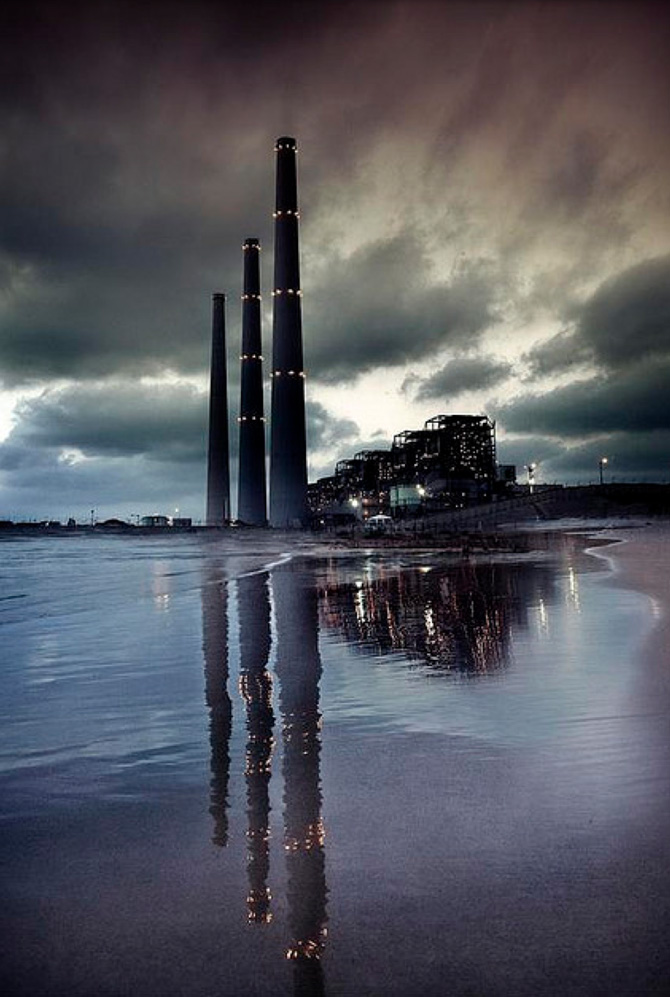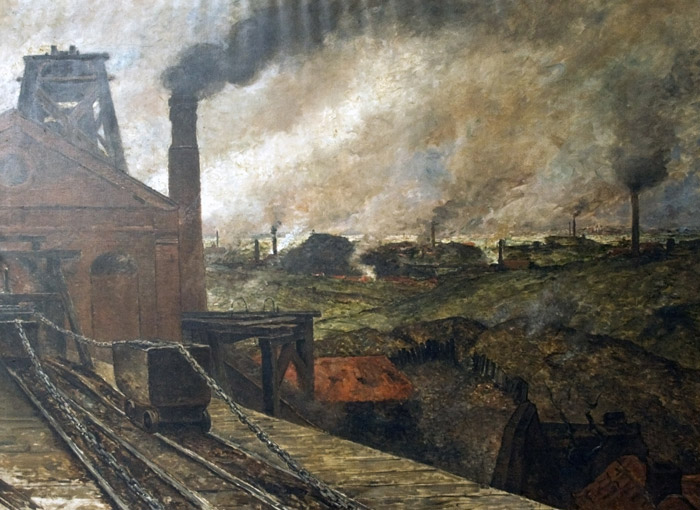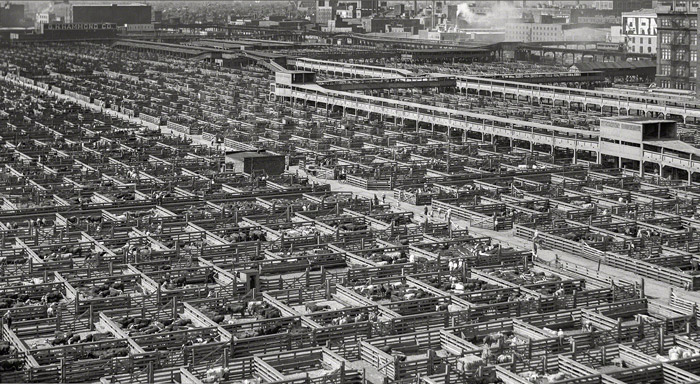Power
Jan 30, 2012
 High-voltage power lines in central Scotland.
High-voltage power lines in central Scotland.
Jan 30, 2012
 High-voltage power lines in central Scotland.
High-voltage power lines in central Scotland.
Nov 17, 2013
 Smokestacks of Israel's largest power plant, Orot Rabin, loom over the beach at Hadera, north of Tel Aviv. The plant's coal-fired turbines produce almost one-quarter of Israel's electricity.
Smokestacks of Israel's largest power plant, Orot Rabin, loom over the beach at Hadera, north of Tel Aviv. The plant's coal-fired turbines produce almost one-quarter of Israel's electricity.
The low structures leading from the chimneys to the left edge of the picture are part of the power station's coal port offshore in the Mediterranean, where ships offload 18,000 tons of coal every day.
The plant is called Orot Rabin–Rabin Lights–in remembrance of Israeli President Yitzhak Rabin, who was assassinated in 1995. Electricity generated here lights much of the country, producing something like the memorial lights of Jewish tradition, helping to keep alive the memory of those who are gone.
Jul 8, 2014
 The Black Country of Belgium is the Borinage district of Wallonia province, where coal was mined to feed the furnaces of the Industrial Revolution from the 1820s until the 1960s.
The Black Country of Belgium is the Borinage district of Wallonia province, where coal was mined to feed the furnaces of the Industrial Revolution from the 1820s until the 1960s.
The countryside was devastated by slag heaps, ash ponds, and smokestacks, and life in and around the mines was brutal. For more than a century, the miners of Borinage organized labor actions that were violently suppressed; in the 1930s, the mine owners evicted strikers from their homes, and families spent the winter sleeping in the streets while soldiers guarded the empty houses.
Since the last of the mines closed in the 1960s, Borinage has been characterized by Belgium's highest unemployment rates.
Constantin Meunier was a Belgian painter and sculptor of the late nineteenth century whose work often focused on the social impact of industrialization. This painting is believed to date to about 1893.
Dec 11, 2014
 It all seems to be true, what the sign says. Destruction specialists meet you right at your car, and they are indeed prompt. They are helpful. Once they've loaded your papers into one of their wheeled carts, they put a put a lid on it, so that all your pre-destructed papers are protected from cameras, eyeballs, gusts of wind, you name it.
It all seems to be true, what the sign says. Destruction specialists meet you right at your car, and they are indeed prompt. They are helpful. Once they've loaded your papers into one of their wheeled carts, they put a put a lid on it, so that all your pre-destructed papers are protected from cameras, eyeballs, gusts of wind, you name it.
But do they really shred the stuff? Well, according to the company's website, you are welcome to come inside the destruction facility and watch for yourself as up to ten boxes of your papers get processed into little shreds.
The viewing isn't free, however; it'll cost you $30. They say the fee reflects costs incurred when the regular workflow is interrupted to do the destructive thing on your stuff right away. Also, inviting a viewer into the facility means that a destruction specialist will have to be pulled away from his or her scheduled destruction and reassigned to escort duty, to protect everybody else's stuff from your prying eyes.
The warehouse in the background of the photo is the home of Office Paper Systems, which contracts with Montgomery County, Maryland, to process mixed-paper recycling from homes and office buildings throughout the county. Added to this paper stream are the remains of the day after FreeSecureShredding's destruction specialists have done their destruction.
Eventually, all the paper, shredded and not, is sold to paper companies, which process it with chemicals, heat, chopping machines, and strainers before mixing it with fresh pulp to make new paper products.
Feb 25, 2016
 In the mid-eighteenth century, Ben Franklin's good friend John Bartram was a nurseryman, with a plant and seed business on a few acres across the Schuylkill River from Phladelphia. This is the view today from Bartram's estate, which is now owned by the city.
In the mid-eighteenth century, Ben Franklin's good friend John Bartram was a nurseryman, with a plant and seed business on a few acres across the Schuylkill River from Phladelphia. This is the view today from Bartram's estate, which is now owned by the city.
The oil tanks are part of the largest refinery complex in the northeast, recently acquired from Sunoco by an investment fund that operates it as Philadelphia Energy Solutions. This year's low oil prices don't seem to hurt the storage-and-refinery end of the oil business; PES says it has expanded its operation locally to employ more than 1,000 people and is trying to acquire a storage facility in North Dakota.
Bartram had an international reputation as a botanist, collecting seeds and plant specimens from all over the thirteen colonies and beyond, from Florida to Lake Ontario. Much of his traveling was by foot. He sent unique New World plants to London for the king's botanists there; they in turn sent him English plants that might or might not be suitable for American climes, including some trees and shrubs that survive today in Bartram's garden.
His son Bill continued the nursery business and also wrote a best-selling travelogue about plant-collecting adventures. Bill's niece Ann then took over the place and expanded it to include ten greenhouses and many acres of nursery gardens; in 1850, however, Ann and her husband Bob Carr ran out of money and had to sell the place.
Mar 1, 2016
In January 1943, Australian truck gardener and food packager Edgell & Sons Ltd opened a new cannery in Cowra, New South Wales, for the war effort; by January 1944, these women and other employees working in shifts around the clock had shipped off one million cans of tomatoes and other vegetables.
The cannery at Cowra stayed in operation till 2013, by which time Edgell had shifted over mostly to frozen foods, and every other cannery in Australia had already closed down. Birdseye now owns the company, though Edgell survives as a brand for the Australian market.
Feb 4, 2018
 For a hundred years, up until 1971, Chicago's Union Stockyards and surrounding meat-packing plants made the city the meat capital of the universe. The industry gave the neighborhood a definite aroma, but of course, it was still the scent of money.
For a hundred years, up until 1971, Chicago's Union Stockyards and surrounding meat-packing plants made the city the meat capital of the universe. The industry gave the neighborhood a definite aroma, but of course, it was still the scent of money.
The city had to make the Chicago River run backwards in order to keep the animal waste out of municipal drinking water.
The stockyards burned to the ground in 1939, but they'd been newly rebuilt by the time of this photo in 1941.